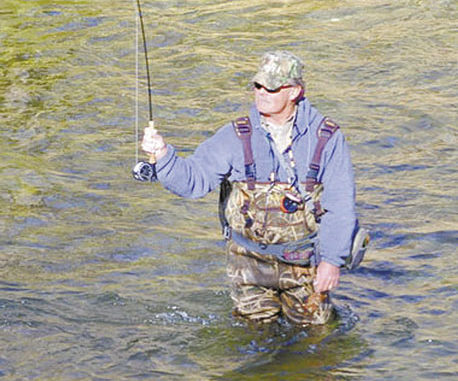
Spring is truly the time of the trout fisher. The weather is perfect for fishing, wildflowers are in bloom, and, best of all, mayfly hatches are emerging. Nothing excites a die-hard fly fisher more than a good mayfly hatch.
Gary Borger, an authority on fly fishing and aquatic insects, calls mayflies “the cornerstone of modern fly fishing” and says, “Throughout our angling heritage have ebbed and flowed the currents of devotion to these insects, upon whose ephemeral qualities the fly fisher has built a sport that endures through time.”
While more than 600 mayfly species have been identified in North America alone, mountain fishers mark the beginning of the spring fly-fishing season when Quill Gordon (Epeorus pleuralis), March Brown (Stenonema vicarium), Blue Quill (Paraleptophlebia adoptivia) and Hendrickson (Ephemerella subvaria) hatches emerge.
Roger Lowe of Waynesville, a third generation fly fisher and guide, said March Brown and Quill Gordon hatches begin showing up in late March and continue into mid-May. “The biggest hatches are during April,” he said “and it’s a major hatch.” Blue Quills emerge in late March, and Hendrickson hatches usually start turning up in April.
Becoming familiar with the life cycles of mayflies — or any other aquatic insect, for that matter — is the first step in becoming a successful trout fisher.
March Brown, Quill Gordon, and Hendrickson are short-lived insects (ephemerals), with their adult stage the briefest part of their life cycle.
Shortly after reaching sexual maturity, adult mayflies (spinners) mate and die. The male dies just after mating; the female dies after depositing her eggs over the water. The fertilized eggs, which have a sticky, jelly-like coating, sink and stick to rocks or other debris on the bottom of the stream. Eggs may hatch within a matter of weeks or lie dormant over the winter and hatch in the spring. When the nymph emerges from the egg, it goes through a succession of sheddings as it grows.
The nymph occupies a place in a stream according to its species. Quill Gordon and March Brown nymphs prefer strong currents and have the ability to cling to rocks, debris, and other structures on the bottom of a stream. Hendrickson nymphs, which crawl about, prefer water with slower currents.
All nymphs, whether clingers, crawlers, or burrowers, sometimes become dislodged and “drift” downstream from their home base, either by choice or because of heavier than normal currents, until they find a new place to lodge. During the drifting process, the nymphs are easy prey for trout. The heaviest free-floating periods generally occur in the evening and early morning or after a heavy downpour.
To imitate a free-floating nymph, Lowe recommends letting a fly dead drift in the current to better imitate the movement of a drifting nymph.
When nymphs are ready to move into the emerger stage of their cycle, they shed their nymphal shell and become duns. Most nymphs shed their shells on the bottom or rise to the surface to shed their shells. A few mayflies crawl out of the water and onto rocks or logs to emerge. When the dun emerges, it sits on the water with wings raised, looking much like a tiny sailboat. After its wings dry, it flies to a bush or other vegetation for a short rest, which can be minutes or days, depending on the weather. After the rest period, a second shell is shed, and the sexually mature spinner emerges, starting the cycle anew.
When Quill Gordon and March Brown duns emerge, they drift very slowly on the surface, and the imitation should be fished accordingly to give trout time to get a bead on the fly and nail it. Hatches occur in the warmest part of the day, usually between 2 and 4 p.m., and in the warmer parts of a stream — flats and the lower ends of large pools.
For good measure, Lowe suggests giving the fly a little twitch when it lands, then letting it drift slowly on the surface.
Suggested sizes for flies are No. 14-12 Quill Gordon (wet or dry), No. 14 Hendrickson, Red Quill or Female Adams, and No. 12 March Brown, wet or dry.
• • • •
Trout season on state hatchery-supported streams opens Saturday, April 3. Creel limit is seven per day with no size limit. Either artificial lures or natural bait may be used. Stream banks are posted with a green and white diamond-shaped sign.
Trout season on Cherokee Enterprise Waters opens March 27. Creel limit is 10 trout, and a tribal permit is required.




Be the first to comment